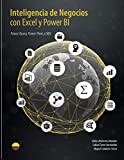Inteligencia de negocios con Excel y Power BI
Atehortúa Morales, D. (2018). Inteligencia de negocios con Excel y Power BI: Una guía exhaustiva para la preparación, análisis y visualización de datos. Bii Soluciones & Excel Free Blog.
Power Pivot (Lenguaje DAX) + Power Query(Lenguaje M) + Visualización con Power BI, Todo en un mismo lugar. Power BI no es un programa para analizar datos, tampoco es un conjunto de tecnologías para el análisis de negocios, Power BI es en realidad y esencia: un estilo de vida.¿Una premisa excesiva?, ni de cerca, es en su lugar la definición más fiel a la realidad, la que mejor encaja cuando nos volcamos en el aprendizaje de la que es hoy por hoy el software líder en BI o Business Intelligence. Te lo vamos a dibujar con detalle: Qué sucede cuando depende de tu voluntad las horas que trabajas, cuando tienes la potestad absoluta de decidir si le dedicas mayor o menor tiempo a un proyecto o tarea laboral, en filtrar y seleccionar entre un trabajo u otro; en que escalar sea una constante del día a día, parte de tu ser.
Learn Python Programming
Romano, F. (2021). Learn Python programming: an in-depth introduction to the fundamentals of Python. Packt Publishing.
This book will help you explore the foundations of Python programming and learn how Python can be used to achieve results.
Este libro lo ayudará a explorar los fundamentos de la programación de Python y aprenderá cómo se puede usar Python para lograr resultados.
Python Crash Course
Matthes, E. (2019). Python crash course: a hands-on, project-based introduction to programming. No Starch Press.
Python Crash Course is the world's best-selling guide to the Python programming language. This fastpoced, thorough introduction will have you writing programs, solving problems, and developing functioning applications in no time.
Python Crash Course es la guía más vendida del mundo sobre el lenguaje de programación Python. Esta introducción rápida y completa lo hará escribir programas, resolver problemas y desarrollar aplicaciones funcionales en muy poco tiempo.
Python para análisis de datos: manipulación de datos con Pandas, NumPy y Jupyter.
McKinney, W., & Aranda González, V. (2023). Python para análisis de datos: manipulación de datos con Pandas, NumPy y Jupyter. Anaya Multimedia.
Manual definitivo para manipular, procesar, limpiar y restringir conjuntos de datos en Python. Actualizado para Python 3.10 y pandas 1.4.0, esta tercera edición de Python para análisis de datos. Manipulación de datos con pandas, NyumPy y Jupyter está llena de casos prácticos, que permiten averiguar cómo resolver una amplia variedad de problemas de datos de una manera efectiva. Con su ayuda conocerás y aprenderás las versiones más recientes de pandas, NumPy, IPython y Jupyter. Es ideal para analistas no versados en Python y para programadores que deseen ponerse al día en ciencia de datos y computación científica o ciencia computacional. GitHub alberga los archivos de datos empleados en el libro y otro material asociado.






